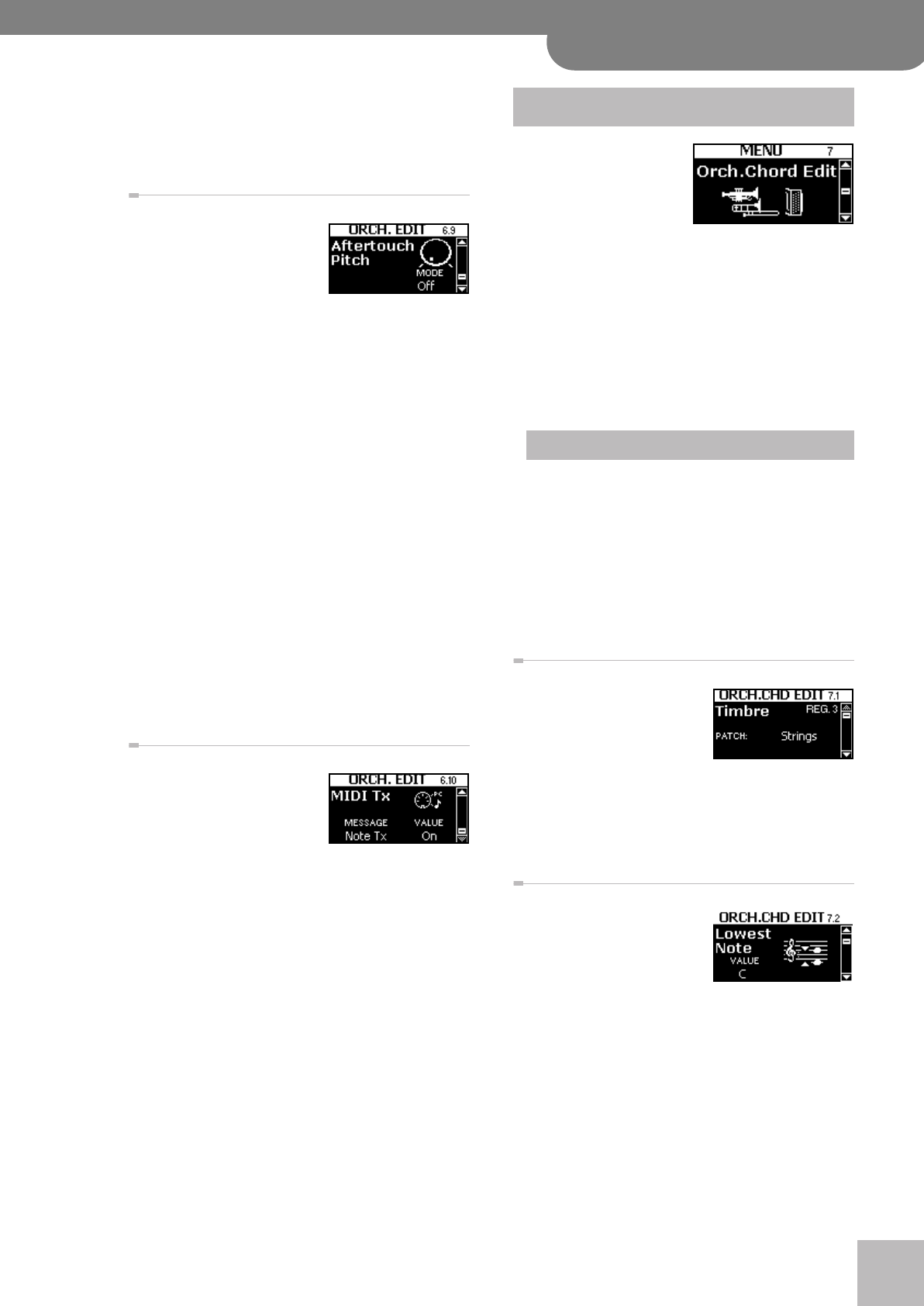
6.9 Aftertouch Pitch (Advanced)
V-Accordion
r
79
Note:
If a TW organ sound is assigned to the current ORCHES-
TRA register memory, the “LEVEL” value will read “Rotary” to
signal that the register is not processed by the FR-7x’s “general
effects” (see p. 55). In this case, the “LEVEL” parameter cannot
be set.
6.9 Aftertouch Pitch
(Off, 1/4 Down, 1/2 Down, 1/4
Up, 1/2 Up, Default setting:
Off)
The treble keyboard of the
piano-type model generates
aftertouch messages (on the button-type model, after-
touch can be generated with the Master bar). “After-
touch” refers to the fact that you press a key even fur-
ther down after playing a note. This effect allows you to
bend the pitch down (temporarily lower the note) by a
quarter (“1/4 Down”) or a semi-tone (“1/2 Down”). Select
“1/4 Up” or “1/2 Up” to bend the notes up a quarter or a
semi-tone. Select “Off” to switch off the Orchestra sec-
tion’s aftertouch recognition.
The treble section also contains this parameter. You are
thus free to decide whether both the accordion and the
orchestral sounds should be affected by aftertouch mes-
sages or only one of them.
Note:
This aftertouch effect applies to all ORCHESTRA notes
that are sounding simultaneously. (MIDI buffs call this “chan-
nel aftertouch”.)
Note:
For organ sounds, aftertouch allows you to alternate
between the fast and slow speeds of the Rotary effect. (That
effect is automatically assigned to an organ sound when you
select it.) The speed switching function cannot be deactivated.
You can, however, also add pitch control to this switching
function, and so control two functions via the aftertouch.
6.10 MIDI TX
This page contains a series of
MIDI parameters for the
Orchestra section you need to
set one by one. See page 113
for details about the MIDI
parameters. These parameters are saved along with all
other Set parameters, which allows you to use different
MIDI settings for each Set.
The parameters of the
“Orch. Chord Edit” group
apply to the chord button
rows of the Bass section.
As stated earlier, the FR-7x
allows you to play and accordion sound with the bass
rows and an orchestral or organ sound with the chord
rows of the bass keyboard (and vice versa). See page 33
for details about the ORCHESTRA CHORD section. (You
can also combine the ORCHESTRA CHORD section with
the ORCHESTRA BASS section if you like.)
See pages 62 and 63 for how to select and adjust the
parameters.
Press
[UP]
and
[DOWN]
simultaneously to select the
value that is indicated as “Default setting”.
•The selection of ORCHESTRA CHORD mode can be
automated using the “2.14 Orchestra Chord Link”
parameter (page 69).
•These parameters can only be selected if an ORCHES-
TRA CHORD register is selected (page 33).
• See page 103 for how to save your changes. Also be
sure to read “Important remark about saving your
settings” on p. 64.
7.1 Timbre
This parameter group allows
you to assign the desired
orchestral or organ sound to
the selected register.
See “Assigning orchestral to
the registers” on p. 51 for the procedure. As stated there,
each register can select only one type of sound.
If you select a TW organ sound, you can also edit and
name it.
7.2 Lowest note
This parameter allows you to
specify the lowest note the
selected sound can sound.
The ORCHESTRA CHORD
sounds are PCM waveforms
(samples) of acoustic instruments. Each acoustic instru-
ment has a set range: it cannot sound notes below or
above that range.
Samples (PCM waveforms), on the other hand, can lower
the pitch of a recorded sound almost indefinitely. But
that doesn’t sound very natural. The “Lowest Note”
parameter allows you to specify the lowest pitch the
sample can use. If you nevertheless play a lower note on
the treble keyboard, it will be sounded one octave above
the corresponding pitch – and sound natural.
7. Orch. Chord Edit parameters
Important notes
FR-7x_2b.GB Page 79 Tuesday, August 25, 2009 2:19 PM


















